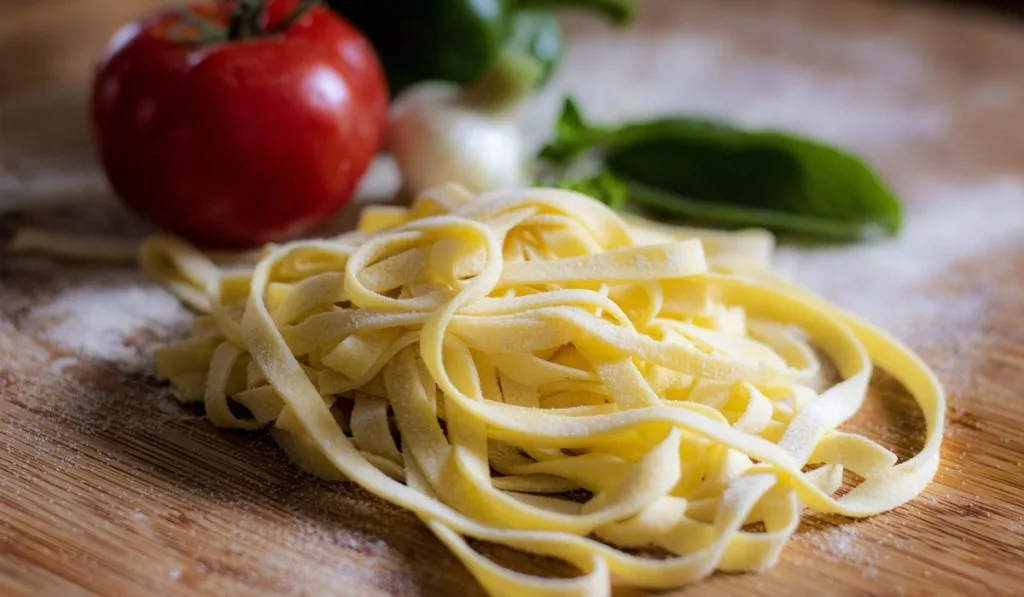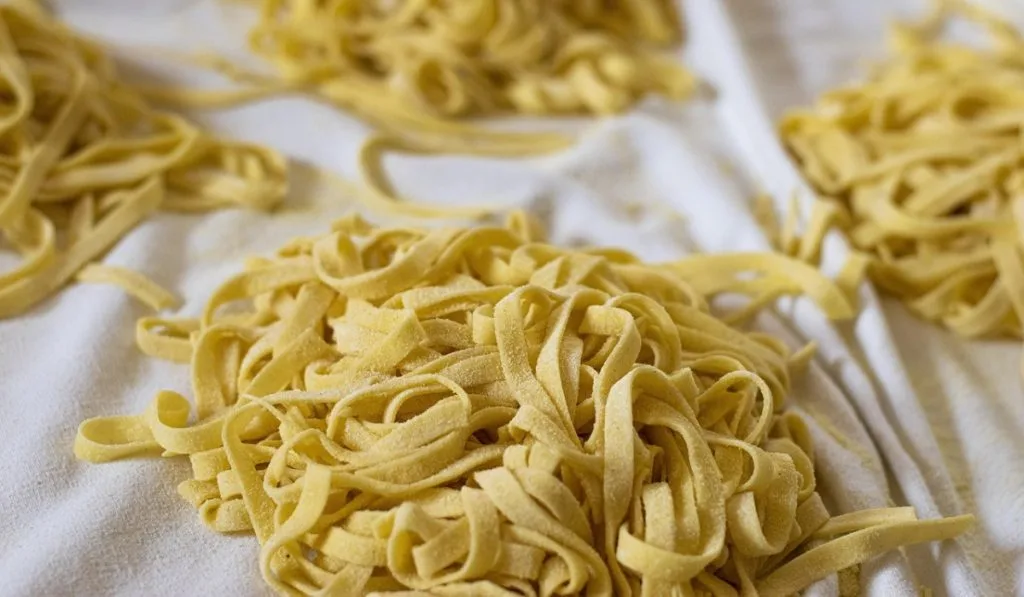You’ve mastered bread. You’ve conquered pancakes. Your starter is thriving. But now you’re staring at a bubbly jar of sourdough wondering—can I turn this into pasta?
You can. You absolutely should. And once you do, you’ll never go back to the boxed stuff again.

Sourdough pasta brings together the ancient art of fermentation and the silky richness of homemade dough. It’s chewy, flavorful, gut-friendly, and shockingly simple. Yet many bakers hesitate, unsure if flour, eggs, and starter alone can really work their magic.
TL;DR — Sourdough Pasta in a Nutshell
- Naturally fermented pasta dough = flavor boost + easier digestion
- No fancy machine needed—just a rolling pin and patience
- Great use for discard or ripe starter
- Fermentation adds subtle tang and beautiful elasticity
- Versatile: shape into fettuccine, ravioli, or lasagna sheets
What Is Sourdough Pasta?
At its core, sourdough pasta swaps commercial flour and water for flour and a bit of your sourdough starter—ripe or discard, both work. It can be made with eggs (like classic Italian pasta) or without (for a vegan-friendly version). But the star of the show is the fermentation.
Just like with sourdough bread, fermentation brings three major wins:
- Flavor: That subtle tang takes plain pasta to wow
- Texture: Elastic, chewy, and rich
- Digestibility: Fermented grains are easier on the gut
Think of it as rustic Italian meets slow fermentation.
Why It’s Worth the Effort
Sourdough pasta isn’t just a fun weekend experiment—it’s a meaningful, hands-on experience that blends tradition, flavor, and nutrition in one chewy, golden bite. While it may sound like a big undertaking, the process is more forgiving than you’d think. The bulk of the work happens while the dough rests, leaving you with plenty of time to enjoy the anticipation. And the rewards? They go way beyond taste.
No Additives, No Preservatives—Just Real Food
Store-bought pasta often contains stabilizers, drying agents, or enriched flours that sound more like lab ingredients than pantry staples. Sourdough pasta strips everything back to the essentials: flour, eggs, and sourdough starter. That’s it. No chemical enhancers, no shelf-life extenders—just nourishing, unprocessed food made with intention.
Zero Waste Cooking at Its Finest
Every sourdough baker knows the guilt of tossing out discard. With sourdough pasta, you give that leftover starter a new purpose. Instead of going down the drain, it becomes part of a rich, elastic dough—reducing waste and boosting flavor. It’s a sustainable habit that turns something “extra” into something extraordinary.
Endless Customization Options
Once you’ve got the basic technique down, the creative floodgates open.
- Add spinach, beetroot, or activated charcoal for vibrant color
- Mix in lemon zest, roasted garlic, or fresh herbs for depth
- Swap in part whole wheat or semolina for texture and nuttiness
- Make it egg-free for a plant-based version
The dough is highly adaptable and welcomes experimentation, whether you’re aiming for nutrition, aesthetics, or bold new flavor combinations.
Flavor That Evolves with Time
Here’s where fermentation really shines. A short 4-hour rest gives your pasta a mild tang—barely there but pleasantly complex. Let it ferment overnight in the fridge and the flavor deepens into rich, almost nutty or buttery territory. You can fine-tune the fermentation window based on your taste preference, making this pasta completely customizable in flavor profile, not just shape.
Better for Your Gut and Digestion
Fermentation isn’t just about taste—it’s also about nutritional upgrades. As the dough rests, wild yeasts and lactobacilli begin breaking down gluten and phytic acid, compounds that can make grains harder to digest. The result?
- Easier digestion, especially for those with minor gluten sensitivities
- Better nutrient bioavailability, since fermentation reduces anti-nutrients
- Gut-friendly benefits, thanks to the presence of natural probiotics
It’s a humble food that quietly supports your body while delivering a gourmet experience on your plate.
Let’s Talk Dough: Ingredients & Tools
Essential Ingredients
- All-purpose flour or semolina flour – You can mix them 50/50 for best texture
- Ripe sourdough starter (100% hydration) – About ½ cup or 120g
- Eggs (for egg pasta) – 2–3 large eggs for every 2 cups flour
- Salt – Just a pinch for flavor
- Olive oil (optional) – For added richness and elasticity
Basic Equipment
- Mixing bowl
- Fork or dough whisk
- Rolling pin or pasta machine (optional)
- Bench scraper
- Cling film or beeswax wrap
- Knife or pizza cutter
- Sheet tray with parchment paper
The Basic Sourdough Pasta Dough Recipe
Here’s my go-to ratio, based on many, many test runs and a couple flour-splattered aprons:
Ingredients:
- 2 cups all-purpose flour
- 2 eggs
- 120g sourdough starter (ripe or discard)
- ½ tsp salt
- 1 tbsp olive oil (optional)
Instructions:
- Form a well in your flour. Crack eggs into the center, add salt and starter.
- Stir with a fork, slowly pulling in flour until it becomes shaggy dough.
- Knead on a floured surface for 8–10 minutes until smooth and elastic.
- Wrap and rest at room temperature for 4–6 hours. Or refrigerate overnight for deeper flavor.
- Roll out and shape into your favorite pasta (fettuccine, tagliatelle, ravioli).
- Boil in salted water for 2–4 minutes, depending on thickness.
Insider Tips
These are the kind of tips you don’t get on the back of the bag:
- Too sticky? Add semolina or bread flour gradually—this dough can be temperamental in humid weather.
- Hard to roll? Let it rest another 30 minutes. Gluten needs time to relax.
- More tang? Ferment overnight in the fridge instead of just 4 hours on the counter.
- Eggless version? Use water and olive oil instead. You’ll still get structure thanks to the starter.
- Shaping hack: Dust with semolina before folding and slicing noodles—no clumps.
Creative Variations to Try
Homemade pasta is a blank canvas. Here are some fun riffs:
- Beetroot Sourdough Pasta – Add 2 tbsp beet purée for color and earthiness
- Lemon-Zest Tagliatelle – Zest of one lemon into your dough = perfect spring pasta
- Charcoal Ravioli – A bit of activated charcoal + goat cheese filling = dramatic dinner
- Garlic Herb Dough – Mix in finely minced herbs (basil, oregano) for aromatic sheets
Best Pairings for Sourdough Pasta
This isn’t just a pretty noodle—it’s flavorful enough to hold its own. So keep the sauces balanced.
Top pairings:
- Brown butter + sage – lets the tang shine
- Tomato confit + burrata – acid + cream = yes
- Wild mushroom cream sauce – earthy flavors match the fermentation
- Simple olive oil + lemon zest – minimalist, stunning
- Cacio e pepe – because black pepper and Pecorino don’t miss

How to Store & Freeze Sourdough Pasta
Fresh pasta can be made ahead—here’s how to do it without sacrificing texture:
To store (short term):
- Fridge: Wrap in plastic, use within 24 hours
- Sheet tray method: Dust with semolina, layer noodles flat, cover loosely
To freeze:
- Shape your noodles
- Flash freeze in nests on a tray for 1 hour
- Transfer to freezer bag
- Boil from frozen, no need to thaw
Common Mistakes to Avoid
Let’s save your future self a headache:
- Under-kneading – Pasta dough needs serious gluten development
- Skipping the rest period – You’ll end up with rubbery, tight noodles
- Too much flour – Makes the dough dry and hard to roll
- Using weak starter – No bubbles = poor fermentation and weak flavor
Final Thoughts: The Beauty of Fermented Pasta
There’s something primal and joyful about turning three ingredients into something so luxurious. Sourdough pasta invites you to slow down, use your hands, and create a meal with memory. It isn’t just about flavor—it’s about honoring tradition while embracing creativity.
So next time you feed your starter, ask yourself: is today a pasta day?
Because once you twirl a forkful of sourdough fettuccine, you’ll understand why this tangy twist is worth every minute.
FAQs About Sourdough Pasta
What kind of sourdough starter should I use for pasta?
You can use either a ripe, active starter or discard. Discard works well since the dough doesn’t need to rise.
How long should I ferment sourdough pasta?
Anywhere from 4 to 24 hours. Longer ferment = stronger flavor and better digestibility.
Can I make sourdough pasta without eggs?
Yes! Use water and olive oil instead for a vegan-friendly version.
Is sourdough pasta healthier than regular pasta?
Thanks to fermentation, it’s gentler on digestion and may help with nutrient absorption.
Does sourdough pasta taste sour?
It has a subtle tang, not overwhelming—more like umami depth than sour bread.
What flour works best?
A mix of all-purpose and semolina flour gives the best texture—silky but with bite.
Can I use sourdough pasta for ravioli?
Absolutely! It holds shape well and complements creamy fillings beautifully.
Can I dry sourdough pasta?
You can air-dry it for 12–24 hours, but fresh or frozen preserves the best texture.
How do I know if my dough is ready?
It should feel smooth, elastic, and slightly tacky. If it tears while rolling—rest it longer.
Do I need a pasta machine?
Nope. A rolling pin and sharp knife are enough, though a machine makes it faster.
Join Us and Transform >
Don’t Be an Amateur! Master the Art of Sourdough Bread!




Leave a comment